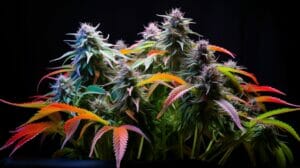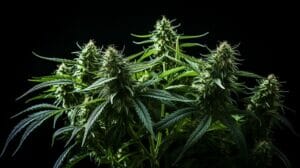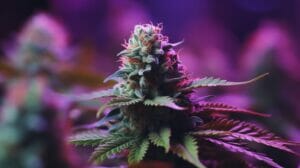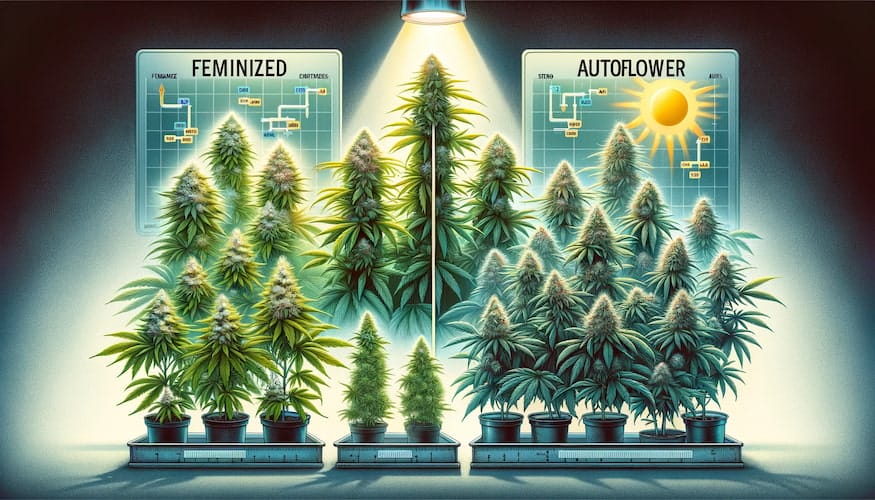Welcome to a delightful exploration of the Bolo Runtz strain, a captivating cannabis hybrid that marries the creamy, decadent notes of Gelato with the vibrant, candy-like flavors of Zkittlez. Whether you’re a cannabis connoisseur or a curious newbie, Bolo Runtz promises a unique experience that tantalizes the senses and soothes the soul. Let’s dive into […]
Exploring Cannabis Phenotypes: A Deep Dive into Varieties

Exploring Cannabis Phenotypes: A Deep Dive into Varieties
Welcome to the exciting world of cannabis phenotypes! If you’re a cannabis enthusiast or someone interested in the science behind the marijuana plant, you’re in for a treat. In this article, we’ll be taking a deep dive into the various types of cannabis strains and their genetic makeup, exploring the fascinating world of cannabis phenotypes.
From indica to sativa and everything in between, cannabis genetics and strain characteristics can be overwhelming at first glance. But fear not! By understanding cannabis phenotypes and their role in creating these variations, you’ll be able to identify and appreciate the differences between the many varieties of marijuana plants.

So please sit back, grab your favorite strain, and explore the world of cannabis phenotypes together!
What are Cannabis Phenotypes?
Cannabis phenotypes refer to the observable characteristics of a cannabis plant that result from its genetic makeup and environmental factors. These characteristics include traits such as the plant’s height, leaf shape, and color, as well as its aroma, flavor, and effects when consumed.
Phenotypes are determined by the plant’s genotype, which refers to its genetic makeup. However, environmental factors such as temperature, humidity, and light can also influence a plant’s phenotype. This means that even if two plants have the same genotype, they can exhibit different phenotypes if grown in different environments.
Cannabis phenotypes play a significant role in classifying and identifying different cannabis strains. They also serve as the basis for cannabis breeding, which involves selecting and crossing plants with desirable phenotypes to create new and improved strains with specific characteristics.

Understanding cannabis phenotypes is essential for anyone looking to explore the diverse world of cannabis varieties. By recognizing different phenotypes and their unique characteristics, growers and consumers can make more informed decisions about which strains to cultivate or consume.
Classifying Cannabis Strains Based on Phenotypes
When it comes to classifying cannabis strains, phenotypes play a significant role. Cannabis strains are typically classified into three categories: sativa, indica, and hybrid. Sativa strains produce a more uplifting and energetic experience, whereas indica strains are known for their relaxing and soothing effects. Hybrid strains are a combination of both sativa and indica genetics.
Phenotypes contribute to these classifications by determining the physical characteristics of a particular strain. Each phenotype has unique traits, such as plant height, leaf structure, and bud shape, which can be used to identify and classify strains. For example, sativa strains typically have thin leaves, tall plants, and long, narrow buds, while indica strains have broader leaves, shorter plants, and dense, compact buds.
Hybrid strains, as the name suggests, are a combination of both sativa and indica phenotypes. These strains can take on the physical characteristics of either parent strain or a combination of both. Hybrid strains are often grown with specific goals in mind, such as combining the uplifting effects of a sativa with the pain-relieving properties of an indica.
The classification of cannabis strains based on phenotypes can be helpful for both growers and consumers. Growers can use this information to select parent plants for breeding, while consumers can use it to understand the effects and characteristics of a particular strain before purchasing.

Understanding Cannabis Genetic Variations
Just like any other living organism, cannabis plants undergo genetic mutations that result in variations in their physical and chemical characteristics. These are called cannabis genetic variations and play a significant role in determining the effects of different cannabis strains.
There are two types of genetic variations in cannabis plants: natural and artificial. Natural genetic variations are mutations that occur spontaneously in the plant’s DNA due to environmental factors such as temperature, humidity, and light exposure. On the other hand, synthetic genetic variations are created intentionally by breeders through cannabis breeding techniques like hybridization, backcrossing, and selection.
One of the most well-known cannabis genetic variations is the difference between indica and sativa strains. Indica strains are known for their relaxing and soothing effects, while sativa strains are known for their energizing and uplifting effects. This effect variation is due to the genetic differences between the two strains.
Other genetic variations in cannabis plants include differences in cannabinoids and terpenes. Cannabinoids are the chemical compounds responsible for the plant’s psychoactive and medicinal effects. There are over 100 cannabinoids in cannabis, the most well-known being THC and CBD. The levels of these cannabinoids vary between cannabis strains, resulting in different medicinal and recreational effects.
Terpenes are essential oils that give cannabis strains their distinctive aroma and flavor. Like cannabinoids, terpenes also have medicinal properties and contribute to the effects of different cannabis strains. Some common terpenes found in cannabis include myrcene, limonene, and pinene.
Understanding cannabis genetic variations is crucial in determining the effects of different cannabis strains and selecting the right strain for a specific purpose. Advances in technology have allowed for a more accurate analysis of cannabis genetics, resulting in a better understanding of the plant’s chemical and physical properties.

“Cannabis genetic variations play a significant role in determining the effects of different strains. Understanding these variations is crucial in selecting the right strain for a specific purpose.”
Identifying Cannabis Phenotypes
Identifying cannabis phenotypes requires a trained eye and knowledge of the plant’s characteristics. Growers and breeders look for certain traits to determine the phenotype of a cannabis plant.
One important characteristic to consider is the plant’s overall morphology. Indica strains are shorter and bushier, while sativa strains are taller with thinner leaves. Hybrids can display a combination of both types. Other physical traits include leaf shape, bud structure, and coloration.
The aroma and flavor of a cannabis strain can also provide clues to its phenotype. Terpenes, the compounds responsible for the plant’s scent, can vary significantly among different phenotypes. Some strains may have fruity or floral aromas, while others may have a more skunky or earthy scent.
Another essential factor to consider is the plant’s effects. Different phenotypes can produce other highs, ranging from cerebral and energizing to relaxing and soothing. Understanding the impact of a strain can help in identifying its phenotype.
Overall, identifying cannabis phenotypes requires a keen eye and attention to detail. By analyzing the plant’s morphology, aroma, flavor, and effects, growers and breeders can determine a strain’s phenotype and better understand the genetic variations that contribute to its unique characteristics.

Analyzing Cannabis Genetics
Advancements in technology have allowed for a deeper understanding of cannabis genetics and the importance of phenotype identification. Analyzing cannabis genetics involves various techniques, including DNA sequencing and marker analysis, to determine the genetic makeup of a plant.
The use of DNA sequencing in cannabis analysis has increased in recent years, providing a more accurate and detailed understanding of genetic variations and traits. By breaking down the genetic makeup of a plant, DNA sequencing allows breeders to select specific traits and develop more desirable phenotypes.
Marker analysis, on the other hand, involves identifying specific genetic markers linked to desirable traits. This approach allows breeders to select plants with these markers and breed for the desired phenotype.
Additionally, phenotypic analysis can also be used to determine the genetic makeup of a plant. By observing the physical characteristics and traits of a cannabis plant, breeders can make informed decisions about its underlying genetics.
Overall, the analysis of cannabis genetics plays a crucial role in developing and breeding new and improved cannabis strains. By understanding the genetic variations and traits of different phenotypes, breeders can create unique and desirable cannabis varieties.

The Role of Cannabis Breeding in Phenotype Variation
Cannabis breeding plays a crucial role in creating and manipulating phenotype variations. Breeders can develop and enhance desirable traits by selecting and crossing different strains, such as potency, flavor, and aroma. This process is crucial not only for producing high-quality cannabis but also for ensuring genetic diversity and preservation of certain strains.
One popular breeding technique is creating hybrids, combining two or more strains. Hybridization can result in a wide range of phenotypes, allowing breeders to develop unique and diverse strains. For example, a breed of Indica-dominant hybrid may have the relaxing effects of an indica strain and a sativa strain’s uplifting effects.
Another approach is backcrossing, where a desired trait from a parent strain is repeatedly bred back into the original strain. This technique enables breeders to enhance specific characteristics and stabilize the genetics of a strain. For instance, a breeder seeking to increase the potency of a strain may backcross it with a high-potency strain multiple times to produce a more potent offspring.
Cannabis breeding is essential for creating and maintaining the diversity of cannabis phenotypes. It allows for the development of new strains with unique characteristics and helps preserve existing strains. The art and science of cannabis breeding is a fascinating pursuit that requires skill, patience, and creativity.
Innovation and creativity in cannabis breeding have led to the creation of diverse and unique strains.
Different Cannabis Strains and Their Phenotypical Traits
When it comes to cannabis, the possibilities are endless. Each strain has its own unique set of characteristics, flavors, aromas, and effects. Whether you’re looking for a relaxing high or a burst of creativity, there’s a strain out there. Let’s explore some popular cannabis strains and their distinct phenotype traits.
 |
Indica Strains |
|---|---|
| Also known as “in-the-couch” strains, indicas are known for their relaxing, sedative effects. They often have a high THC content and are characterized by their short, bushy plants with broad leaves. Some popular indica strains include: |
|
 |
Sativa Strains |
|---|---|
| Sativa strains are known for their cerebral, uplifting effects that can generate creativity and energy. They typically have a higher percentage of THC to CBD and are characterized by their tall, slender plants with narrow leaves. Some popular sativa strains include: |
|
 |
Hybrid Strains |
|---|---|
| As the name suggests, hybrid strains combine indica and sativa genetics, creating unique blends of effects and flavors. They can be Indica-dominant, Sativa-dominant, or balanced. Some popular hybrid strains include: |
Of course, this is just a small selection of the countless cannabis strains out there. Each strain has its distinct combination of phenotype traits, making it unique and appealing to different individuals. Whether you’re a seasoned cannabis connoisseur or a new user just starting to explore, there’s always something new to discover in the world of cannabis phenotypes.
Varieties of Marijuana Plants: A Phenotype Showcase
Now that we have explored the classification and genetic variations of cannabis strains let’s take a closer look at some popular varieties and their unique phenotype traits. From colorful buds to intense aromas, each strain offers something unique to cannabis enthusiasts.
| Strain | Phenotype Traits |
|---|---|
| GSC (Girl Scout Cookies) |
|
| Sour Diesel |
|
| Blue Dream |
|

“The diversity of cannabis phenotypes is truly remarkable. Each strain has its own unique set of features and effects, making every experience with the plant a little bit different. It’s like discovering a new world every time you try a new strain.”
Whether you prefer the indica, sativa, or hybrid varieties, there is a phenotype for every taste and preference. So why not explore the intriguing world of cannabis phenotypes and discover what makes each strain unique?
Understanding Cannabis Variations: Phenotypes vs. Genotypes
When it comes to understanding cannabis variations, it’s essential to differentiate between two terms: phenotypes and genotypes. Genotype refers to the genetic makeup of a plant, while phenotype encompasses the observable traits resulting from those genes.
Phenotypes are the characteristics we can see, such as plant height, yield, and flowering time, while the genotype refers to the specific letters or sequences of letters in the plant’s genetic code. While the genotype determines the potential of a plant, the phenotype represents what is expressed.
For example, if two cannabis plants with different genotypes but similar phenotypes are crossed, their offspring may have the same observable traits as their parent plants despite their genetic differences. On the other hand, if two plants with similar genotypes but different phenotypes are crossed, their offspring may exhibit different observable characteristics.
Understanding the distinction between phenotypes and genotypes is crucial for cannabis breeding and the production of specific strains. Breeders can create new phenotypes by crossing plants with different genotypes by selecting desirable traits.
“Phenotypes are like the fingerprint of the cannabis plant, unique and distinct. Understanding this concept can help growers and breeders fine-tune their craft and produce truly exceptional cannabis strains.”

So, while the genotype may be the blueprint, the phenotype determines what you see and experience. By studying and understanding these observable traits, we can gain insight into the underlying genetics and create new and exciting cannabis varieties.
The Intriguing World of Cannabis Phenotypes: What Makes Them Special?
From the classic strains like sativa and indica to the new-age hybrids, the cannabis plant has always been shrouded in mystery. However, with the discovery of cannabis phenotypes, this enigmatic plant has become even more fascinating!
Each phenotype has unique characteristics, like potency, flavor, aroma, and appearance. The way that different phenotypes can express their genetic variations is what makes each cannabis strain special and unique.
Exploring the world of cannabis phenotypes is like embarking on an exciting adventure with endless possibilities. One can discover new flavors, aromas, and effects with each phenotype, adding to the thrill of the experience.
Moreover, understanding cannabis phenotypes is exciting and essential for growers and breeders. Identifying and studying a phenotype can help them achieve their desired strain characteristics and create new variations.
So, what makes cannabis phenotypes unique? They can express genetic variations in diverse and exciting ways, providing users with a never-ending array of options and growers with the opportunity to create new and exciting strains.

FAQ: Common Questions about Cannabis Phenotypes
What is the significance of cannabis phenotypes?
Cannabis phenotypes are essential in understanding the vast world of cannabis varieties. They contribute to different strains’ unique characteristics, flavors, aromas, and effects, giving each one its distinct identity.
How do growers and breeders identify cannabis phenotypes?
Growers and breeders look for various characteristics and traits such as leaf shape, growth pattern, bud structure, and color to identify cannabis phenotypes. They also conduct genetic testing and analyze the plant’s DNA to determine its genetic makeup.
What are the different classes of cannabis strains based on phenotypes?
The different classes of cannabis strains based on phenotypes are indica, sativa, and hybrid. Indica strains are known for their calming and soothing effects, while sativa strains are uplifting and energizing. Hybrid strains combine both indica and sativa and offer a balance of impact.
What is the difference between cannabis phenotypes and genotypes?
While genotypes refer to the genetic makeup of a plant, phenotypes encompass the observable traits resulting from those genes. Phenotypes are the characteristics that can be seen and experienced by consumers, while genotypes are the underlying genetic information that determines those traits.
How do breeders manipulate phenotype variations through cannabis breeding?
Breeders select and cross different cannabis strains to achieve desired characteristics and phenotypes. By identifying desirable traits, they can create new strains with specific qualities and effects, such as higher THC content or a unique aroma and flavor profile.
What makes cannabis phenotypes unique and special?
Cannabis phenotypes offer endless possibilities and variations within the cannabis plant kingdom. Each strain has its distinct identity, flavor, and effect, making exploring cannabis varieties exciting and intriguing.
Why is understanding cannabis phenotypes important for consumers?
Understanding cannabis phenotypes is essential for consumers to find a strain that best suits their needs and preferences. By identifying the unique characteristics and effects of different phenotypes, consumers can make informed decisions and have a more enjoyable and personalized cannabis experience.
Back





